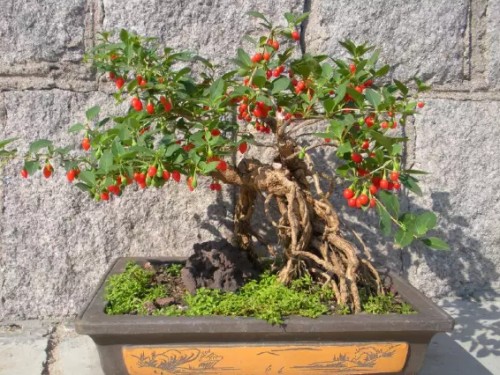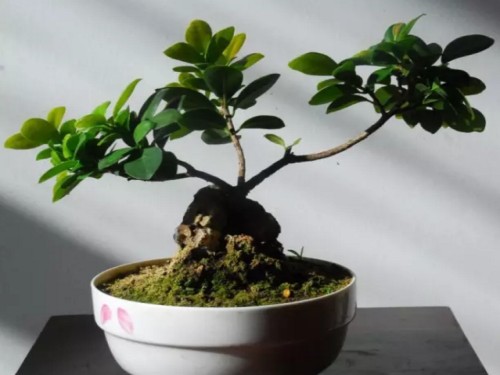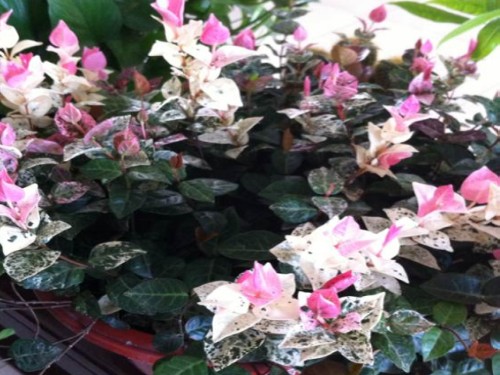What about Chinese wolfberry bonsai leaves and yellow fallen leaves
Chinese wolfberry is a kind of nourishing traditional Chinese medicine, this plant has strong sprouting and tillering, it has been appreciated by potted plants since ancient times, usually the branches of Chinese wolfberry hang very elegant, its flowers are purple, and the red fruit is covered with branches after autumn, no matter when the ornamental effect is very good.
The branching ability of Chinese wolfberry is strong, and the new branches grow vigorously. Every year, the old branches should be cut off before germination in early spring, the overgrown branches should be cut off in summer, and the old branches and disease and insect branches should be cut off in autumn. Pruning can reduce diseases and insect pests, enhance ventilation and light transmission, and reduce nutrition consumption. Newly planted Chinese wolfberry seedlings, when the trunk is 60 cm high, go to the top, leaving 3 to 5 lateral branches. In the second year, the selected 3-5 lateral branches were retracted to 30 cm to form the first crown. After that, it will be cultivated year by year to form a three-story "upstairs" tree crown and increase the amount of fruit hanging. If you make bonsai, you can cut off the sturdy branches of Chinese wolfberry before germination in the spring of the following year, and then blossom and bear fruit in the coming year.

The main reason for the yellow fallen leaves of Chinese wolfberry bonsai leaves is the symptoms of yellow fallen leaves caused by watering too wet or the basin soil plate is too hard or too dark.
The main results are as follows: 1. The hard impervious soil plate results in that the irrigated water can not penetrate into the soil layer, resulting in most of the roots unable to absorb water and nutrients, resulting in the symptoms of loss of water and conservation of leaves and falling leaves of yellow leaves. The best way is to loosen the soil properly, which is beneficial to soil loosening, ventilation, drainage and root growth.
2. Lycium barbarum likes positive plants, if it is placed indoors for a long time, it is easy to cause the phenomenon of yellow leaves and fallen leaves, and if it is best to put it in a sunny ventilation place indoors, it is better to move out of the sun for 2 hours in the morning and evening when you are free.
3. The phenomenon of yellowing and falling leaves caused by watering is not easy to be too wet at ordinary times, and the over-wet soil is easy to cause root rot and leaf yellowing. It is best to keep the soil dry after watering, so that it is not conducive to root growth in order to prevent the phenomenon of yellowing and falling leaves.
But it is worth noting that now is the season of falling leaves of Chinese wolfberry, as long as we carry out normal maintenance and management, there will be new buds in half a month, when flowers and leaves grow together, pay attention to water and fertilizer management, red fruit will be full of branches and green leaves will be green in autumn.
As long as we do a good job in the daily maintenance of Chinese wolfberry bonsai, we can not only avoid its yellow leaves, but also make it luxuriant and luxuriant, so let's learn the maintenance methods of Chinese wolfberry bonsai:
1, place: Chinese wolfberry should be placed in a sunny place, such as in the shade, it is not conducive to blossom and bear fruit. Avoid direct sun in summer, can bear cold in winter, and can spend the winter in the open air above-10 ℃.
2. Watering: usually watering should be dry and wet, according to the principle that if it is not dry or watered, it must be thoroughly watered. During the flowering and fruiting period, we should pay attention to watering the right amount to prevent it from being too dry or too wet.
3, fertilization: to apply thin fertilizer frequently, early summer and early autumn combined with picking leaves, can each apply a slightly thicker fertilizer, in order to promote the emergence of new leaves and buds. Proper fertilization can be applied before and after sprouting to make the fruit large and the plant strong. Do not fertilize too much and during the flowering period.
4. Pruning: big pruning and plastic surgery are carried out every winter and spring. Usually at any time to cut off diseased branches and dense branches, maintain a certain tree shape. Get rid of sprouting in time.
5. Turn the basin: every 1-2 years, the time should be in the early spring. When turning the basin, remove half of the old soil and replace it with loose and humus-rich culture soil, which can apply less base fertilizer. Cut off the withered roots and some of the overgrown old roots. It is important to turn the basin and change the soil. If the basin is not turned for many years, the basin soil is consolidated, and the drainage is poor, which will seriously affect the tree potential.
6. Pest control: the main diseases of Lycium barbarum are powdery mildew and black fruit, which can be controlled by Baume 0.3-0.5 stone sulfur mixture. In the early stage of the disease, fungicides such as carbendazim, carbendazim, mancozeb and triadimefon can be used alternately for prevention and treatment. The main pests are aphids, wood lice, gall mites and so on that feed on leaves. They can be sprayed with 90% crystal trichlorfon, 50% phoxim EC, 40% omethoate, methamphetamine and other new insecticides and acaricides.
Time: 2019-06-01 Click:
- Prev

Causes and treatment of fallen leaves of banyan bonsai
The banyan bonsai refers to the banyan potted plant which is molded by various means with the banyan tree as the material and for the purpose of ornamental. The banyan tree is very vigorous and easy to maintain and manage, but sometimes it also encounters some problems, such as falling leaves and so on. Now many friends like to raise banyan bonsai.
- Next

The Culture method of potted Flower and Leaf Stone
Flowers and leaves turn into stones, and leaves turn into flowers. Mosaic stone can be propagated by cuttings in any season of the year, but spring and autumn are generally chosen, because the rooting rate can reach more than 98% in both seasons. In a year, nitrogen fertilizer can be mainly applied from March to August to promote plant growth.
Related
- Fuxing push coffee new agricultural production and marketing class: lack of small-scale processing plants
- Jujube rice field leisure farm deep ploughing Yilan for five years to create a space for organic food and play
- Nongyu Farm-A trial of organic papaya for brave women with advanced technology
- Four points for attention in the prevention and control of diseases and insect pests of edible fungi
- How to add nutrient solution to Edible Fungi
- Is there any good way to control edible fungus mites?
- Open Inoculation Technology of Edible Fungi
- Is there any clever way to use fertilizer for edible fungus in winter?
- What agents are used to kill the pathogens of edible fungi in the mushroom shed?
- Rapid drying of Edible Fungi

